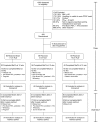Effect of Continuous Positive Airway Pressure on Airway Reactivity in Asthma. A Randomized, Sham-controlled Clinical Trial
- PMID: 27398992
- PMCID: PMC5122477
- DOI: 10.1513/AnnalsATS.201601-043OC
Effect of Continuous Positive Airway Pressure on Airway Reactivity in Asthma. A Randomized, Sham-controlled Clinical Trial
Abstract
Rationale: Studies have demonstrated that application of stress suppresses airway smooth muscle contractility. In animal models of asthma, continuous positive airway pressure (CPAP) reduced airway reactivity. Short-term studies of CPAP in patients with asthma showed reductions in airway reactivity.
Objectives: To evaluate whether nocturnal CPAP decreased the provocative concentration of methacholine to reduce FEV1 by 20% (PC20).
Methods: One hundred ninety-four individuals with asthma were randomized (1:1:1) to use CPAP with warmed, filtered, humidified air at night at pressures either less than 1 cm H2O (sham) or at 5 cm H2O or 10 cm H2O. The primary outcome was change in PC20 after 12 weeks.
Measurements and main results: Adherence to CPAP was low in all groups. Regardless, all groups had a significant improvement in PC20, with 12 weeks/baseline PC20 ratios of 2.12, 1.73, and 1.78 for the sham, 5 cm H2O, and 10 cm H2O groups, respectively, and no significant differences between the active and sham groups. Changes in FEV1 and exhaled nitric oxide were minimal in all groups. The sham group had larger improvements in most patient-reported outcomes measuring asthma symptoms and quality of life, as well as sinus symptoms, than the 5 cm H2O group. The 10 cm H2O group showed similar but less consistent improvements in scores, which were not different from improvements in the sham group.
Conclusions: Adherence to nocturnal CPAP was low. There was no evidence to support positive pressure as being effective for reducing airway reactivity in people with well-controlled asthma. Regardless, airway reactivity was improved in all groups, which may represent an effect of participating in a study and/or an effect of warm, humid, filtered air on airway reactivity. Clinical trial registered with www.clinicaltrials.gov (NCT01629823).
Keywords: CPAP; PC20; airway reactivity; asthma; methacholine.
Figures



Comment in
-
Continuous Positive Airway Pressure and Airway Hyperreactivity in Asthma: Lessons for Patients with Obstructive Sleep Apnea?Ann Am Thorac Soc. 2016 Nov;13(11):1885-1886. doi: 10.1513/AnnalsATS.201608-642ED. Ann Am Thorac Soc. 2016. PMID: 27831810 No abstract available.
References
-
- Gunst SJ, Shen X, Ramchandani R, Tepper RS. Bronchoprotective and bronchodilatory effects of deep inspiration in rabbits subjected to bronchial challenge. J Appl Physiol (1985) 2001;91:2511–2516. - PubMed
-
- Fredberg JJ, Inouye D, Miller B, Nathan M, Jafari S, Raboudi SH, Butler JP, Shore SA. Airway smooth muscle, tidal stretches, and dynamically determined contractile states. Am J Respir Crit Care Med. 1997;156:1752–1759. - PubMed
-
- Gunst SJ. Effect of length history on contractile behavior of canine tracheal smooth muscle. Am J Physiol. 1986;250:C146–C154. - PubMed
-
- Gunst SJ, Stropp JQ, Service J. Mechanical modulation of pressure-volume characteristics of contracted canine airways in vitro. J Appl Physiol. 1990;68:2223–2229. - PubMed
Publication types
MeSH terms
Substances
Associated data
Grants and funding
LinkOut - more resources
Full Text Sources
Other Literature Sources
Medical

